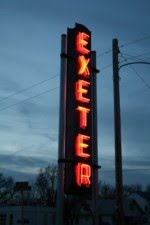Madison Luzum and Kiah Songster. Boys in the background are Wesley Ronne, Braden Capek, Casey Underwood (back to camera) and Kole Svec
Casey Underwood and Braden Capek (back to camera)
Science
Happenings at Exeter-Milligan
By Matt Nicholas,
E-M Science Instructor
Eighth grade
earth science is not for the faint of heart. We dive deep into the mysteries of
the earth. We are currently studying the Theory of Plate Tectonics. In the
early to mid 20th century, the ideas of Continental Drift and Seafloor
Spreading were combined to explain the occurrence of many of the geologic
events and structures we see on a daily basis. The 8th grade students have been
analyzing how those structures and events correspond to the physical plate
boundaries that we see on earth today. We have used Google Earth to show that
the frequency of earthquakes and volcanoes is concentrated in those plate
boundary regions, but not all plate boundaries are the same. Some are
Convergent (colliding), Divergent (moving apart), or Transform (sliding past
each other), and these different types of boundaries produce different
structures. For example, the Highest and Lowest places on earth are both
produced by a convergent boundary. Mount Everest, part of the Himalayan
Mountains, is the result of the Indian subcontinent plowing into Asia 50
million years ago, and The Mariana Trench, in the western Pacific Ocean, is the
result of the pacific plate subducting under the asian plate.
Understanding how our earth formed 4.5 billion years ago, and that
the same geologic processes have be shaping and reshaping the surface for Eons
allows us to have some perspective on the scope and scale of the planet we live
on. The earth is a big, complex place, but it can be understood. We can learn
from the earth’s past and help us prepare for the future.
As part of this unit the students were required to write a paper
summarizing an earthquake or volcanic event that occurred sometime in the past.
I have included a few excerpts below.
“Sometimes, we lose everything. You might even lose yourself, but
together we can start a chain reaction, like when you touch the water and wave
after wave follows. Sometimes, you need to lose everything to see how much you
truly have.”
-Katelyn Babula, Novarupta 1912
“After the eruption many people thought that the area would never
recover. They couldn’t have been more wrong. If you went back know the only
sign that something happened would be the form of the Mountain, the occasional
rusted out car, and the dead trees left from the burn down zone that are still
standing.”
-Kole Svec, Mt. St. Helens 1980
“The U.S. Army's relief efforts
during the 1906 earthquake and fire not only answered the needs of the
immediate tragedy but also left a legacy for future domestic emergencies. Based
on the army's experience in the 1906 disaster, clear and formal policies were
developed regarding civil relief and the Army's relationship with the Red Cross
was formally defined.”
-Ben Bartu, San Francisco Earthquake 1906
Our students
showed such compassion for the people that they were writing about and were so
hopeful in their outlooks. It helps me be optimistic for our future knowing
that the kids we are raising will become caring adults. I think that they will
be excellent representatives of our school and community in the future.
During our review
of this chapter, the students were tasked with drawing a subduction zone and
labeling all of the features that go with it. Pictured are some of the students
at various stages in their drawings.




No comments:
Post a Comment